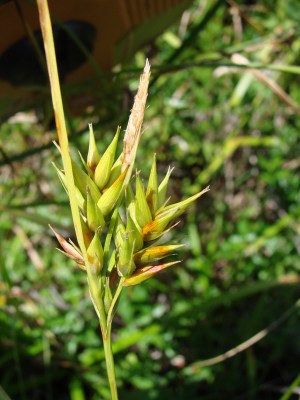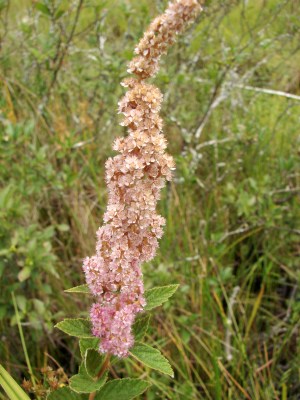By Steve Young
On May fifth NYFA began their annual meeting and field trip with a visit to Nelson Swamp near Nelson, NY. We met on a beautiful sunny day just outside the village of Cazenovia and carpooled to a parking spot that provided easy access to the swamp.

Field trip participants walk into the swamp.
The participants divided into two smaller groups so we would have less impact on sensitive areas. While some of us explored the mosaic of marsh and white cedar swamp to the west, the other group went into the swamp to take a look at spreading globeflower.


In one area we came across a beautiful expanse of false hellebore (Veratrum viride) in its early stages of growth as well as some nice meadows of Carex bromoides (“the other hummock sedge” as David Werier describes it). At the appointed time we exchanged places with the other group and listened to Dr. Sara Scanga talk about her work with Spreading globeflower (Trollius laxus) before heading into the swamp to look at the plant for real.

For some of the group it was the first time they had seen globeflower and Sara explained all of the interesting facets of its growth and ecology. You can learn more about her work HERE.

Fortunately the plants were in full flower and put on a real show for us.


You can learn more about spreading globeflower in New York at the NY Natural Heritage Conservation Guide.
After the field trip we drove to board member Ed Frantz’s house near Cazenovia and enjoyed a delicious and bountiful lunch provided by Ed and his family. After lunch came a short business meeting with a board member vote followed by the first annual botanical quiz given by yours truly from an iPhone app called “Angiosperms.” Even though there were a lot of groans at the questions, I think everyone enjoyed participating, especially the two groups that tied for the win!

Board members Rich Ring and Andy Nelson with wife Mary Anne enjoying the botanical quiz.
We finished off the day’s activities by voting for the 2014 Wildflower of the Year, a tradition that we will have every year to honor and publicize a member of our flora for the next calendar year. This year’s win went to cardinal flower, one of our most spectacular and well-known wildflowers.

Cardinal flower at Indian Lake in the Adirondacks.
Many thanks go to the organizers of the field trip and luncheon and to the record number of participants we had for the meeting. It was one to remember.
 I took a stroll along the Mohawk Bike Path in Aqueduct, Niskayuna today to see what wildflowers I could find. The trail runs at the base of a slope where it meets the floodplain of small creeks flowing into the Mohawk River. Here are the wildflowers that greeted me along the way.
I took a stroll along the Mohawk Bike Path in Aqueduct, Niskayuna today to see what wildflowers I could find. The trail runs at the base of a slope where it meets the floodplain of small creeks flowing into the Mohawk River. Here are the wildflowers that greeted me along the way.













































































